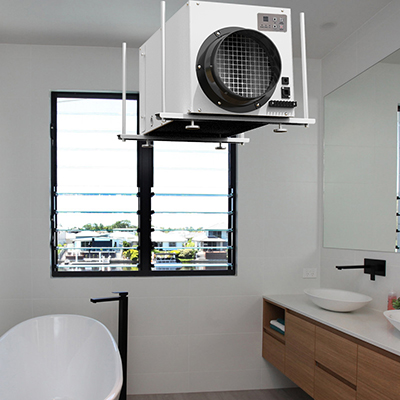- Professional Home Dehumidifier Manufacturer -
Ⅰ. How Do Mold and Mildew Grow?
Mold and mildew are both types of fungi that grow in similar conditions, but they have some differences in their appearance and growth habits.
Both mold and mildew require moisture to grow. This could be from a water leak, high humidity levels, or flooding. Both mold and mildew require organic matter to feed on. This could be anything from wood and paper to fabric and drywall. They grow best in warm temperatures between 77-86°F (25-30°C), but they can grow at lower temperatures as well. Once mold or mildew spores have found a suitable environment with moisture, nutrients, and the right temperature, they will begin to grow and multiply. Mold can start to grow in as little as 24-48 hours, while mildew can start to grow in a few days.
Mold can appear fuzzy or slimy, and comes in a variety of colors, including black, green, and white. Mildew is usually gray or white in color and has a powdery appearance.
Ⅱ. What Health Problems Can Mold and Mildew Cause?
Mold and mildew can both cause a variety of health problems, especially for people who are sensitive or allergic to them. Here are some of the health problems that mold and mildew can cause:
Fatigue
Exposure to mold and mildew can cause fatigue and a feeling of being run down.
Headaches
Exposure to mold and mildew can cause headaches, especially in people who are sensitive to them.
Irritation of the skin, eyes, and throat
Exposure to mold and mildew can cause irritation of the skin, eyes, and throat.
Infections
In some cases, exposure to certain types of mold and mildew can lead to infections, especially in people with weakened immune systems.
Respiratory problems
Exposure to mold and mildew can cause respiratory problems, such as wheezing, coughing, and shortness of breath. This is especially true for people with asthma or other respiratory conditions.
Allergic reactions
Mold and mildew can cause allergic reactions, such as sneezing, runny nose, and itchy eyes. Some people may develop a rash or hives after exposure.
It's important to address mold and mildew problems promptly to prevent health problems.
Ⅲ. How to Get Rid of Mold and Mildew?
Getting rid of mold and mildew can be a challenging process, especially if the infestation is extensive or has been left untreated for a long time. To get rid of mold and mildew, there are some suggestions for you:
Find the source of moisture
Get related cleaning tools
Remove the mold & DRY the area
1. Identify the source of moisture:
Mold and mildew require moisture to grow, so it's important to identify and fix the source of moisture before attempting to remove the mold or mildew.
2. Wear protective equipment:
Mold and mildew can be harmful to human health, so it's important to wear protective equipment such as gloves, eye protection, and a mask when working with mold or mildew.
3. Clean up the mold or mildew:
The best way to clean up mold or mildew is to use a solution of water and detergent, or a specialized mold cleaner. Use a scrub brush or sponge to scrub the affected area and remove as much of the mold or mildew as possible.
4. Dry the area:
Once the mold or mildew has been removed, it's important to dry the area thoroughly to prevent further growth. Use fans and/or a dehumidifier to dry the area completely.
5. Dispose of contaminated materials:
Any materials that are contaminated with mold or mildew should be disposed of properly. This may include drywall, carpeting, or other porous materials.
6. Prevent future growth:
To prevent future growth of mold or mildew, it's important to control moisture levels in indoor environments, fix water leaks promptly, and ensure proper ventilation in areas with high humidity levels.
To prevent their growth, it's important to control moisture levels in indoor environments, fix water leaks promptly, and ensure proper ventilation in areas with high humidity levels. If the mold or mildew infestation is extensive or has caused significant damage, it may be necessary to work with a professional mold remediation company to safely and effectively remove it.
Ⅳ. Does a Dehumidifier Help with Mold?
A whole house dehumidifier can help with mold problems by reducing the moisture in the air, which makes it more difficult for mold to grow and spread. Mold requires moisture to grow, so by removing excess moisture in the air, a dehumidifier can help to prevent the growth of mold.
A whole home dehumidifier works by pulling moisture out of the air and collecting it in a reservoir or draining it out through a hose. This reduces the overall humidity levels in a room or building, which can help to prevent the growth of mold. If you want to buy energy efficient dehumidifiers for home, please contact Preair for detailed information about home dehumidification.
If mold is already present, it's important to work with a professional mold remediation company to safely and effectively remove it and address the underlying causes of the moisture problem. After the mold remediation company finished the job, the house owner can equip a whole house dehumidifier to control the humidity level. Additionally, a dehumidifier should be used in conjunction with other preventative measures, such as fixing any water leaks, improving ventilation, and properly maintaining HVAC systems.
Zhejiang Preair Electrical Appliance Industry Co., Ltd.
Post time: Apr-27-2023
 +86-13376814803
+86-13376814803  robert@hzhongtai.com
robert@hzhongtai.com 















